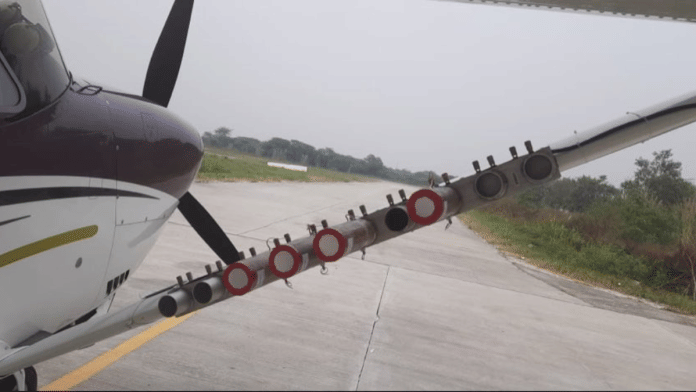The sky was full of clouds as the aircraft soared, dispersing rain seeds. The air was cool with moisture. With folded hands, you pleaded with the cloud-seeding gods: Rain, rain.
The rain didn’t oblige.
The next day, Wednesday, another aircraft roared into view: “Rashtrapati in Rafale… soars in the skies,” said India Today. Six months after Operation Sindoor, President Droupadi Murmu took off on a Rafale sortie from Ambala Air Force station — a first for the supreme commander of the Indian armed forces.
If only Murmu could have plucked up a few rain clouds along the way and brought them back to Delhi. If only that were possible….
What was possible is another first: On Tuesday, the first experiment to induce rainfall in the capital by cloud-seeding to reduce air pollution was apparently “successful” but failed to bring rain.
Or, more accurately, there was “…light rainfall of 0.1 and 0.2 mm each… reported from Noida and Greater Noida in the National Capital Region (NCR) at 4 pm,” according to The Indian Express.
“Cloud seeding done, rain on airplane wing and a prayer,” wrote The Times of India in its lead on 28 October – and so the citizens of Delhi and NCR continue to pray.
How hard we stared out of the window, how long we stood outside, heads upturned to the sky on Tuesday afternoon — straining our eyes to make it happen, just waiting for that moment to sing B J Thomas’ “Raindrops keep fallin’ on my head.”
Television news channels assured us that once the cloud-seeding was completed on Tuesday afternoon, rain could be expected anytime between 15 minutes and four hours later (NDTV 24×7).
“Whenever you like, get rainfall,” claimed Times Now Navbharat with glee. “Jab chaho, baarish kar lo.”
Artificial expectation
Not quite. On this occasion, our expectations were artificially high, perhaps because we all wanted it to rain in Delhi so badly.
None more so than the television news reporters stationed in different parts of Delhi where the cloud-seeding had been done—Burari, Mayur Vihar, Karol Bagh.
For nearly four hours, from 2 pm to 6 pm, they stood outside bravely, waiting for rain — just one drop would do. “Rain likely soon,” was the hopeful refrain on the lips of reporters across English news channels. Most Hindi news channels, however, chose to ignore the historic experiment with artificial rain. Barring TNNB, Aaj Tak, and NDTV India, the others spent Tuesday afternoon in Bihar, covering the forthcoming Assembly election.
“Rain likely in some time,” (Times Now). “Artificial rain likely,” (CNN News 18). “We may see rain by 5 pm-6 pm,” (NDTV 24×7). “Any time now,” (India Today).
As the clock ticked on, hope and despair were evident in their reports. If words could induce rain, theirs surely would have.
Finally, the India Today reporter in Delhi’s Connaught Place raised his voice: “There is something,” he said. He wasn’t “exactly sure” what, but he “felt something”. We felt elated and rushed to look out of the window, for the nth time.
No rain.
A day drenched in drama
To fill time until the rain arrived, TV news channels helpfully explained the science behind cloud-seeding — and most did so knowledgeably. In fact, this was one of those rare occasions when both anchors and reporters seemed genuinely well-informed about the subject at hand.
Through graphics, they patiently explained how artificial rain was created, what climate conditions were required for the clouds, and what the pros and cons of the process were.
‘Silver iodide’ tripped off their tongues like quicksilver. TNNB and CNN News 18, Aaj Tak and NDTV 24×7 tracked the origins of artificial rains, countries where it had been used — including Pakistan — and the efforts of IIT Kanpur to make it rain in Delhi.
“Cloud-seeding (gives) reluctant clouds a bit of a push…(need) right kind of clouds… success depends on the weather,” said the CNN News 18 anchor.
News channels showed us the Cessna aircraft, its funnel throwing out pellets of silver iodide—this filled us with hope.
But it was short-lived.
Even as we watched a video message from Delhi Environment Minister Manjinder Singh Sirsa telling us the cloud seeding had been successful and Chief Minister Rekha Gupta made reassuring sounds, TV anchors and reporters began to dampen our spirits.
Will it reduce pollution?” asked News X. Relief from pollution is “temporary” was the conclusion—that is, if it rained at all.
They told us that “some relief and respite” could be expected, if “clouds permit…” (CNN News 18).
India Today said the moisture in the clouds were “low” — up to only 20 per cent when more than 50 per cent was required.
“We may not see rain,” declared Aaj Tak.
“Sit back and pray to the weather gods,” advised the CNN News 18 anchor.
“Artificial rain, 50 per cent unlikely to happen,” added NDTV 24×7 as we went past 5.30 pm without a drop of rain.
The evening gave way to the night without any change. We shut our windows, closed our eyes.
Oh well, it was an experiment worth trying.
Better luck next time.
Meanwhile, let’s hope Indian batters rain fours and sixes on Australia in the second semi-final of the ICC Women’s World Cup today.
The author tweets @shailajabajpai. Views are personal.
(Edited by Prashant)






